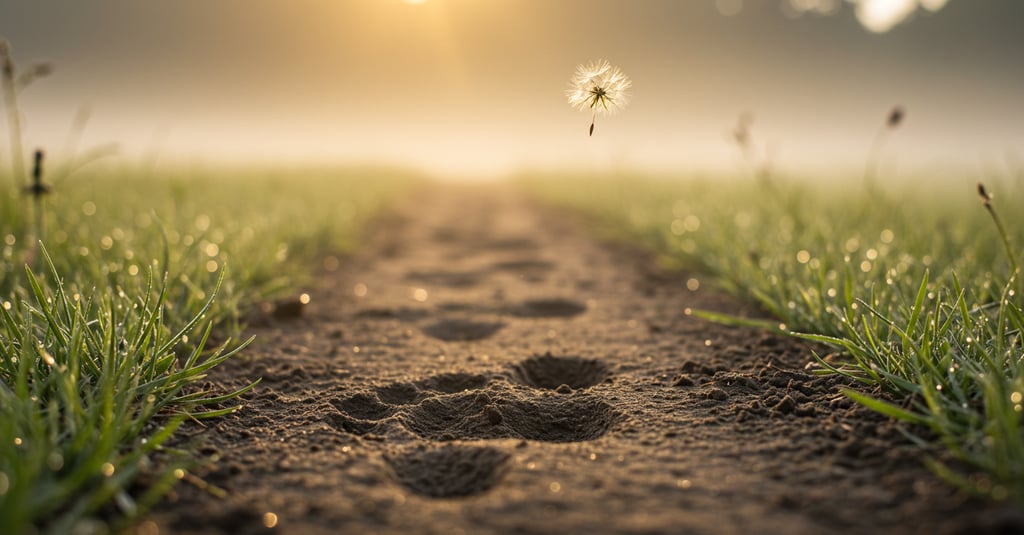"Barefoot Through Grief: How Grounding Helped Me Breathe After Loss"
When my world shattered, the earth still held me. Here’s how to let it hold you too.
GROUNDING WITH C'AH
CahSole.com
7/19/20254 min read


The day after the funeral, I walked into the backyard barefoot. The cold shock of dew-soaked grass was the first thing I'd felt in weeks. Grief had numbed me—but the earth whispered, "I'm still here."
Loss has a way of untethering us from everything familiar. The ground beneath our feet suddenly feels unstable, our nervous system stays locked in survival mode, and we float through days feeling disconnected from our own bodies. But what if I told you that reconnecting with the literal ground beneath you could help you find your way back to yourself?
The Science Behind Earth's Embrace
When we're grieving, our bodies carry the weight of emotional trauma in ways we're only beginning to understand. Research published in the Journal of Alternative and Complementary Medicine shows that direct skin contact with the earth—a practice called grounding or earthing—can significantly reduce cortisol levels and inflammation while improving sleep and emotional regulation.
Grief doesn't just live in our hearts; it lives in our nervous systems. The sympathetic nervous system gets stuck in overdrive, leaving us feeling anxious, disconnected, and physically drained. Grounding helps activate the parasympathetic nervous system—our body's natural "rest and digest" response—creating space for healing to begin.
When we place our bare skin against the earth, we're literally connecting with the planet's natural electrical field. This isn't mystical thinking; it's measurable science. The earth's surface carries a negative charge, and when we make direct contact, our bodies can absorb these free electrons, which act as natural antioxidants and help reduce the inflammation that often accompanies emotional trauma.
The Earth Embrace Practice: A Three-Step Ritual for Heavy Days
When grief feels overwhelming, this simple practice can help you find your footing—literally and figuratively.
Step 1: Ground Your Feet Find a patch of natural earth—grass, soil, sand, or even a single potted plant. Remove your shoes and socks. Stand with your feet flat against the ground, feeling the texture beneath your soles. Even two minutes of this contact can begin to shift your nervous system. If you're indoors or it's winter, placing your hands on the soil of a houseplant can offer similar benefits.
Step 2: Heart to Earth Place both hands over your heart and take three deep breaths. Feel the rhythm of your own life force. Then slowly lower your palms to touch the earth beside your feet. Imagine drawing strength up from the ground through your hands and feet, letting it flow through your body like gentle electricity.
Step 3: Breathe Your Truth Inhale slowly, silently saying "I am held." Feel the earth supporting you from below and the sky opening above you. Exhale slowly, saying "I release." Let go of whatever feels too heavy to carry in this moment. You don't have to release the love or the memories—just the weight that's crushing your chest.
Why Barefoot Walking Eases Grief's Physical Weight
Grief isn't just an emotional experience; it's a full-body phenomenon. Many people report feeling physically heavier when they're grieving, as if they're carrying an invisible weight. This isn't imagination—it's your nervous system trying to protect you by creating a sense of groundedness through tension and compression.
Walking barefoot on natural surfaces helps release this physical holding pattern. The varied textures and temperatures stimulate thousands of nerve endings in your feet, sending signals to your brain that you're safe and supported. This foot-to-earth connection helps reorganize your nervous system, often leading to deeper sleep, reduced muscle tension, and a greater sense of embodiment.
The key is to walk slowly and mindfully. This isn't about exercise or getting somewhere; it's about letting each step remind you that you're still here, still breathing, still held by something larger than your pain.
A Memorial Ritual: Planting Seeds of Remembrance
One of the most beautiful ways to combine grounding with honoring your loved one is through a simple planting ritual. Choose a small seed or seedling—something that represents a quality you admired in the person you've lost. It might be sunflower seeds for their warmth, herbs for their nurturing nature, or wildflowers for their free spirit.
With your bare hands, dig a small hole in the earth. As you place the seed in the soil, ask yourself: "What quality of theirs do I want to grow in me?" Cover the seed with soil, pressing gently with your palms. This physical act of planting creates a tangible connection between your grief, your love, and the ongoing cycle of life.
As you tend to this plant in the coming weeks and months, you're not just caring for a seed—you're nurturing the part of your loved one that continues to live through you. Each time you water it, you're practicing the art of tending to both growth and loss simultaneously.
When Earth Needs Extra Support
Grounding practices are powerful tools for navigating grief, but they're not meant to replace professional support when you need it. If you're experiencing thoughts of self-harm, unable to function in daily life, or feeling completely overwhelmed by your grief, please reach out to a counselor, therapist, or grief support group.
The beauty of grounding is that it complements other forms of healing beautifully. You can practice earthing before therapy sessions to help you feel more centered, or use it as a way to integrate what you've learned in counseling. Many therapists are now incorporating somatic practices like grounding into their work because they recognize that healing happens not just in our minds, but in our bodies and our relationship with the natural world.
Finding Your Footing in the Landscape of Loss
Grief is not a problem to solve—it's a landscape to walk through, one barefoot step at a time. Some days the ground will feel solid beneath your feet, and other days it might feel like quicksand. Both experiences are part of the journey.
The earth has been holding grieving humans for thousands of years. It knows something about loss and renewal, about the seasons of death and rebirth, about the way life continues even in the midst of profound change. When you feel lost in your grief, remember that you don't have to find your way alone. The ground is always there, ready to support you, ready to remind you that you belong to something larger than your pain.
Where will you let the earth hold you today? Maybe it's as simple as stepping outside and feeling grass beneath your feet. Maybe it's sitting against a tree and letting its roots remind you of your own deep connections. Maybe it's holding a handful of soil and remembering that you, too, are part of this beautiful, broken, ever-renewing world.
For more tools to navigate loss with gentle resilience, visit cahsole.com and explore our Grief & Grounding resource library. Your soles—and soul—deserve support.

